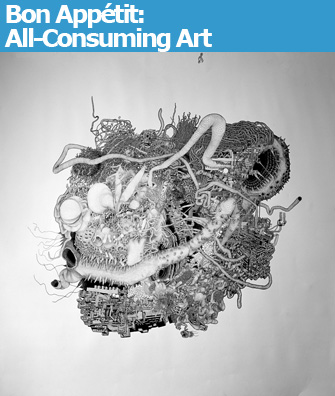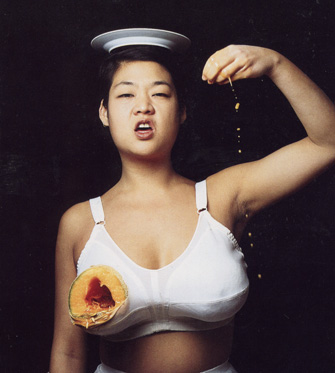 |
|
Jérôme Zonder’s “Macrophage 0” (2006). Collection of Antoine de Galbert. |
Conceptual art requires a great deal of patience. I always wonder why I should stand around in a museum looking at murky photos of some performance …
 |
|
Jérôme Zonder’s “Macrophage 0” (2006). Collection of Antoine de Galbert. |
Hungry? You may be tempted to eat your children after seeing the exhibition “Tous Cannibales” (“Cannibals All”) at the Maison Rouge in Paris, by the end of which such a barbarous act will seem perfectly normal.
This may come as a shock, but some artists love to shock, and most of us are fascinated by shocking pictures. “Tous Cannibales” traces the depiction of anthropophagy (fancy word for eating human flesh) throughout art history, with a number of historical works but with the emphasis on young living artists. Curator Jeanette Zwingenberger has supposedly avoided the “gore” movement (although some might say that there is plenty of gore in the show, including Adriana Varejâo’s gag-making installation straight out of a horror movie, in which masses of bloody guts explode through a white-tiled wall) and has chosen works – about half of them by women – that approach “the cruelty of the subject” with a critical eye and “a certain delicacy.”
It is true that a surprising number of these works exhibit “a certain delicacy.” Many are detailed, finely drawn grotesqueries that must be studied carefully to take in their subject matter, often rendered not realistically but in a way that just suggests the horrors (or joys?) of anthropophagy, among them Alvaro Oyarzun’s “Composition 5” (2009) or Jérôme Zonder’s intricate “Macrophage 0” (2006; pictured above).
Munching on babies is a popular subject and has been so throughout history. Who hasn’t heard a mother saying to her baby, “You’re so cute, I just want to eat you up”? Some of the artists in the show take this expression literally. On the other side of the coin are the fetus in the womb and the baby at the breast, both feeding on the mother’s body, which also provide fodder for works in the show.
For those who prefer snacking on more mature flesh, quite a few images take up the subject. Makoto Aida offers illustrated recipes for young women: squeezing out eggs, cooked up in soup or rolled up with rice in sushi (a young man looking at this picture the other day said to his friend, “I could go for some sushi.”).
Exploding the body into pieces, another of the show’s themes, makes it easier to consume. Gilles Barbier does this with humor in several works here, including one, “Untitled (Aaaah!),” in which the organs of a partly cut-open man on a dissecting table are floating free in the air above him and exalting in their new freedom (“Finally, some air!” says one).
One of the most horrific exhibits is John Isaacs’ “Matrix of Amnesia” (1997), a realistic sculpture of a naked, obese person lying on the floor, hand protectively wrapped around a breast and a hole where the head should be, the body partly deflated as if the pressure had blown the head off.
And what show on cannibalism would be complete without the engravings of Goya and his admiring contemporary successors, brothers Jake and Dinos Chapman, who have themselves cannibalized their master by drawing over his “Disasters of War” engravings. Examples of the work of both are on display.
One of the grossest yet most affecting pieces is Patty Chang’s video, “Melons (At a Loss)” (1998), in which the performance artist stands
 |
|
From Patty Chang’s video “Melons (At a Loss)” (1998). Collection of Antoine de Galbert. |
with a porcelain plate on her head and tells a story about her dead aunt while scooping out the contents of her breast with a spoon and eating it.
By the way, the dress made of meat on show here, called “Vanitas: Flesh Dress for an Albino Anorexic,” is by Jana Sterbak and is not the one worn by Lady Gaga at the Video Music Awards last September, although many commentators have remarked on the similarity of the two and the fact that the Gaga gave no credit for the idea to Sterbak, who created the original in 1987.
Well you have been warned, but – as noted at the beginning of this review – by the end of the show, nothing will shock you.
La Maison Rouge: 10, boulevard de la Bastille, 75012 Paris. Métro: Quai de la Rapée or Bastille. Tel.: 40 01 08 81. Open Wednesday-Sunday, 11 a.m.-7 p.m. (until 9 p.m. on Thursday. Admission: €7. Through May 15. www.lamaisonrouge.org
Reader Margo Berdeshevsky writes: “Having seen the exhibit, and certainly having been deeply disturbed and, too, turned inward: Yes, shocking. yes, amazing. But in our age of self-absorption, what else is that – but cannibalism? And, in a time when war, the ultimate cannibal, is tolerated – monsters, but “our monsters” after all – what’s so shocking anymore? Joseph Campbell’s words come to mind: ‘A dream is a private myth. A myth is a public dream’.”
Support Paris Update by ordering books from Paris Update’s Amazon store at no extra cost. Click on your preferred Amazon location: U.K., France, U.S.
Reader Reaction: Click here to respond to this article (your response may be published on this page and is subject to editing).
More reviews of Paris art shows.
© 2011 Paris Update
